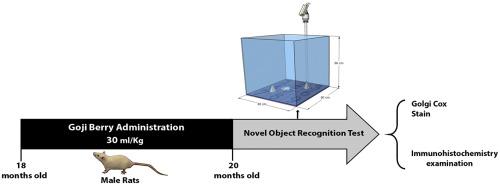The Journal of Nutritional Biochemistry ( IF 5.6 ) Pub Date : 2020-05-17 , DOI: 10.1016/j.jnutbio.2020.108416 Ana Karen Ruíz-Salinas 1 , Rubén A Vázquez-Roque 1 , Alfonso Díaz 2 , Guadalupe Pulido 2 , Samuel Treviño 2 , Benjamín Floran 3 , Gonzalo Flores 1

|
The main characteristic of brain aging is an exacerbated inflammatory and oxidative response that affects dendritic morphology and the function of the neurons of the prefrontal cortex (PFC) and the hippocampus. This consequently causes memory loss. Recently, the use of the Goji berry (Lycium barbarum) as an antioxidant extract has provided neuroprotection and neuroplasticity, however, its therapeutic potential has not been demonstrated in aging conditions. The objective of this study was to evaluate the effect of Goji administration on memory recognition, as well as the changes in the dendritic morphology of the PFC and Hippocampus pyramidal neurons in old rats. Goji (3 g/kg) was administrated for 60 days in 18-month-old rats. After the treatment, recognition memory was evaluated using the new object recognition task (NORt). The changes in the neuron morphology of the PFC and hippocampus pyramidal neurons in old rats were evaluated by Golgi-cox stain and immunoreactivity for synaptophysin, glial fibrillary acidic protein (GFAP), caspase-3, 3-nitrotyrosine (3-NT) and nuclear factor erythroid 2-related factor 2 (Nrf2). The rats treated with Goji showed a significant increase in dendritic morphology in the PFC and hippocampus neurons, a greater immunoreactivity to synaptophysin and a decrease in reactive astrogliosis and also in caspase-3, in 3-NT and in Nrf2 in these brain regions was also observed. Goji administration promotes the plasticity processes in the PFC and in the hippocampus of old rats, critical structures in the brain aging process.
中文翻译:

枸杞子(枸杞)的治疗可改善衰老大鼠前额叶皮层和海马的神经可塑性。
脑衰老的主要特征是炎症和氧化反应加剧,影响树突形态和前额叶皮层(PFC)和海马神经元的功能。因此,这会导致内存丢失。最近,使用枸杞(枸杞))作为抗氧化剂提取物已提供了神经保护作用和神经可塑性,但是,在衰老条件下尚未证明其治疗潜力。这项研究的目的是评估枸杞给药对记忆识别的影响,以及老年大鼠中PFC和海马锥体神经元树突形态的变化。在18个月大的大鼠中服用Goji(3 g / kg),持续60天。处理后,使用新的对象识别任务(NORt)评估了识别记忆。高尔基考克斯染色和突触素,胶质纤维酸性蛋白(GFAP),caspase-3,3-硝基酪氨酸(3-NT)和核细胞的免疫反应性评估了老大鼠PFC和海马锥体神经元的神经元形态变化。因子红系2相关因子2(Nrf2)。用Goji处理的大鼠在这些脑区的PFC和海马神经元中树突形态显着增加,对突触素的免疫反应性增强,反应性星形胶质细胞减少以及caspase-3、3-NT和Nrf2也减少。观测到的。枸杞给药可促进PFC和老年大鼠海马中的可塑性过程,这是大脑衰老过程中的关键结构。


























 京公网安备 11010802027423号
京公网安备 11010802027423号